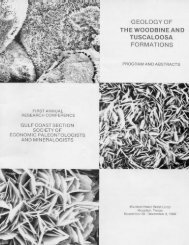Petroleum Systems of Deep-Water Basins - Gulf Coast Section SEPM
Petroleum Systems of Deep-Water Basins - Gulf Coast Section SEPM
Petroleum Systems of Deep-Water Basins - Gulf Coast Section SEPM
You also want an ePaper? Increase the reach of your titles
YUMPU automatically turns print PDFs into web optimized ePapers that Google loves.
Capillary Seals as a Cause <strong>of</strong> Pressure<br />
Compartmentation in Sedimentary <strong>Basins</strong><br />
L. M. Cathles<br />
Department <strong>of</strong> Earth and Atmospheric Sciences<br />
Cornell University<br />
Ithaca, New York 14853<br />
e-mail: cathles@geology.cornell.edu<br />
Abstract<br />
A new hypothesis that pressure compartmentation in basins can be caused by capillary seals is presented and discussed.<br />
Capillary seals form when a non-wetting fluid phase is generated within or introduced into grain-size layered<br />
sediments that are fine-grained enough that gravitational separation <strong>of</strong> the phases does not occur. Experiments show<br />
that such seals can be formed in the laboratory. These seals have many important implications: The changes in basin<br />
permeability that allow fluid overpressuring may occur when non-wetting phases are generated in the basin (CO 2 or<br />
hydrocarbon). Basin seals can be dynamic; they can move through the sediment column. Porosity pr<strong>of</strong>iles reflect such<br />
movement. Hydrocarbons and water may follow the trajectory <strong>of</strong> seal rupture and move along the same migration<br />
routes. The flow <strong>of</strong> both water and hydrocarbons may be directed to areas where the top <strong>of</strong> overpressure is covered by<br />
the least sediments. We have not proven the capillary seal hypothesis, but diverse evidence supports it and it has<br />
important implications.<br />
39

















